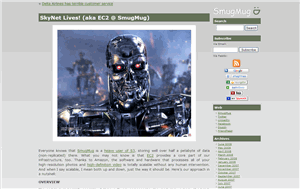AWS News Blog
The Emerging Cloud Service Architecture
|
|
I’m going to go out on a limb today and try to paint a picture of where some of this cool and crazy cloud-based infrastructure may be going. While none of what I will write about is idle speculation, it is based on just a few data points, and may be totally off base. However, I do get to talk to plenty of entrepreneurs and developers on a daily basis, and I am starting to see a very interesting pattern emerge.
 The existing state of the art in cloud-based architectures takes the shape of an application running in the cloud, calling upon services running within and provided by the operator of the cloud. There are any number of great examples of this type of architecture. Doug Kaye at IT Conversations built and documented his implementation over a year ago. Earlier today, Don MacAskill of SmugMug send me a link to his new post, SkyNet Lives (aka EC2 @ SmugMug). In that article, Don provides a detailed review of SmugMug’s use of Amazon EC2 and S3 to implement a dynamic, highly scalable system which simultaneously minimizes response time and cost by optimizing the number of EC2 instances.
The existing state of the art in cloud-based architectures takes the shape of an application running in the cloud, calling upon services running within and provided by the operator of the cloud. There are any number of great examples of this type of architecture. Doug Kaye at IT Conversations built and documented his implementation over a year ago. Earlier today, Don MacAskill of SmugMug send me a link to his new post, SkyNet Lives (aka EC2 @ SmugMug). In that article, Don provides a detailed review of SmugMug’s use of Amazon EC2 and S3 to implement a dynamic, highly scalable system which simultaneously minimizes response time and cost by optimizing the number of EC2 instances.
As I said, I am starting to see something which goes beyond this in a subtle yet important way. Developers are now building services in the cloud for other developers, with the understanding that important (and perhaps primary) consumers of the service will also be resident within the same cloud.
I’m going to call this the CSA, or Cloud Service Architecture.
Applications communicating with each other inside of the Amazon cloud enjoy some important benefits. They get high-bandwidth, low-latency communication, at little or no cost. They inherit all of the other attributes of cloud-based applications such as on-demand scalability, fault tolerance, cloud-wide network security, and cost efficiency. Applications running in loosely coupled fashion within the cloud can share data using SQS, S3, or other communication protocols of their choosing.
Right now, I see that forward-looking companies are starting to build components which fit into the CSA. On the database side, we have Vertica for the Cloud and MySQL Enterprise for EC2. On the media side, there’s Cruxy’s MuxCloud, IntrIdea’s MediaPlug, and Wowza Media Server Pro for Amazon EC2. I’m sure that there are others that I don’t know about.
 So who’s calling these services from other EC2 instances within the cloud? Here are my first two data points (that’s enough to draw a trend line, right?):
So who’s calling these services from other EC2 instances within the cloud? Here are my first two data points (that’s enough to draw a trend line, right?):
- I had breakfast with the CEO of Sonian yesterday. He told me that they are now using the Vertica product to help them store, index, and retrieve massive amounts of data (more info can be found in their case study).
- Earlier this year I paid a visit to VisualCV in Reston, Virginia. They use MediaPlug to support uploading and processing of a variety of types of images and videos.
My sense is that this is the start of something big. Web services made it possible to cross organizational boundaries with a simple HTTP request. Now, running within the cloud makes it possible to do this with minimal network latency.
As individual developers learn more about cloud computing, they will naturally look for some very high-level components up and running within the cloud. Over time I am sure that there will be a need for more sophisticated tracking and billing mechanisms, key management, a catalog of services, and other facilities that we can’t even envision just yet. As always, we love to get this feedback from you, so let us know what you need.
I’m sure that there are some other CSA-style applications running in the Amazon cloud now. If you’ve built one, post a comment!
— Jeff;
